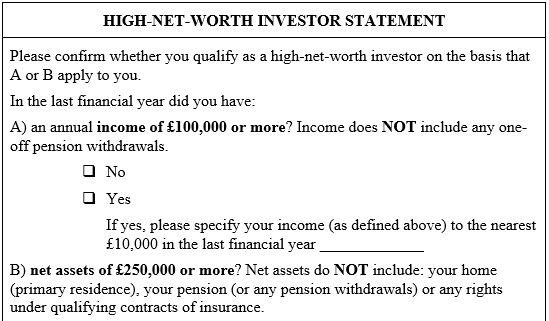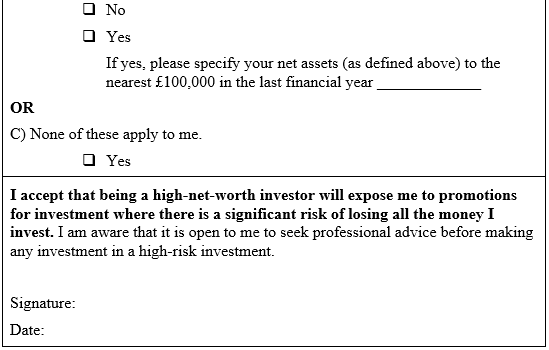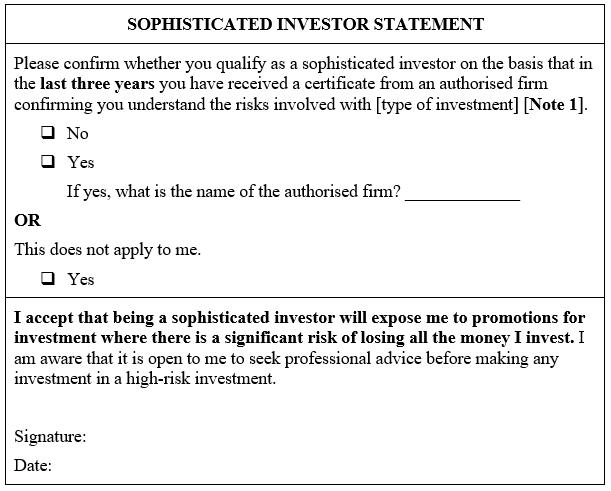COBS 4.1 Application
Who? What?
1This chapter applies to a firm:
-
(1)
communicating with a client in relation to its designated investment business (other than MiFID, equivalent third country or optional exemption business)10;
- (1A)
10communicating with a client in relation to its MiFID, equivalent third country or optional exemption business;
-
(2)
communicating or approving a financial promotion other than:
- (a)
a financial promotion of qualifying credit, a home purchase plan or a home reversion plan; or
- (b)
a financial promotion in respect of a non-investment insurance contract; or
- (c)
a promotion of an unregulated collective investment scheme that would breach section 238(1) of the Act if made by an authorised person (firms may not communicate or approve such promotions); or8
8 - (d)
a financial promotion in relation to a credit agreement, a consumer hire agreement or a credit-related regulated activity; or14
8 - (e)
a financial promotion in relation to a funeral plan contract or a regulated funeral plan activity.14
- (a)
- (3)
9when a MiFID investment firm or a credit institution is communicating in connection with selling, or advising clients in relation to, structured deposits as specified by COBS 1.1.1AAR.
6 COBS 4.4.3R applies to a firm with respect to the activity of issuing electronic money.
- (1)
15TP firms must comply with the rules in (3) and (4) 16 to the extent that those rules do not already apply to those TP firms as a result of GEN 2.2.26R.
- (2)
Gibraltar-based firms must comply with the rules in (3) and (4) 16to the extent that those rules do not already apply to such a Gibraltar-based firm as a result of GEN 2.3.1R.
- (3)
The rules are those in:
- (a)
COBS 4.5.2R (communicating with retail clients – general rule);
- (b)
COBS 4.10 (approving and confirming compliance of financial promotions); and
- (c)
COBS 4.11 (Record keeping: financial promotion).
- (a)
- (4)
16The rules are those in this chapter in so far as they relate to the communication and approval of financial promotions relating to qualifying cryptoassets.
15 COBS 4.12A.3R and COBS 4.12B.1R apply the rules on promoting restricted mass market investments and non-mass market investments to TP firms and Gibraltar-based firms.
17A firm is reminded of its obligations under the naming and marketing rules in ESG 4.3 (in particular, ESG 4.3.1R) when it:
- (1)
communicates or approves a financial promotion that references the sustainability characteristics of a product or service; or
- (2)
undertakes sustainability in-scope business in relation to a sustainability product.
-
(1)
4This chapter applies in relation to an authorised professional firm in accordance with COBS 18 (Specialist regimes).
-
(2)
This chapter applies, to a limited extent, in relation to communicating or approving a financial promotion that relates to a deposit if the deposit is a structured deposit, cash deposit ISA or cash deposit CTF.
A firm is required to comply with the financial promotion rules in relation to a financial promotioncommunicated by its appointed representative even where the financial promotion does not require approval because of the exemption in article 16 of the Financial Promotion Order (Exempt persons).
[Note: see section 39 of the Act]
-
(1)
In COBS 4.3.1 R,9 the defined term9 "financial promotion" includes:11
99- (a)
in relation to MiFID, equivalent third country or optional exemption business, all communications that are marketing communications within the meaning of MiFID; and11
- (b)
in relation to insurance distribution, all communications that are marketing communications within the meaning of IDD.11
- (a)
-
(2)
In the case of MiFID, equivalent third country or optional exemption business9, certain requirements in this chapter are subject to an exemption for the communication of a third party prospectus in certain circumstances (see recital 73 of the MiFID Org Regulation)9. This has a similar effect to the exemption in article 70(1)(c) of the Financial Promotion Order, which is referred to in the definition of an excluded communication.
-
(3)
In this chapter “financial promotion” and “direct offer financial promotion” include communications that are marketing communications for the purposes of the UCITS Directive.5
9A firm communicating with an eligible counterparty should have regard to the application of COBS to eligible counterparty business (COBS 1 Annex 1 Part 1).
Approving a financial promotion without communicating it (which includes causing it to be communicated)3 is not MiFID, equivalent third country or optional exemption business9. Communicating a financial promotion to a person, such as a corporate finance contact or a venture capital contact, who is not a client within the meaning of COBS 3.2.1 R (1), COBS 3.2.1 R (2) or COBS 3.2.1 R (4) in respect of the MiFID, equivalent third country or optional exemption business9 to which the financial promotion relates,3 is also not MiFID, equivalent third country or optional exemption business9. Further guidance on what amounts to MiFID business may be found in PERG 13.
2 3A reference in this chapter to MiFID, equivalent third country or optional exemption business9 includes a reference to communications that occur before an agreement to perform services in relation to MiFID, equivalent third country or optional exemption business9.
[Note: see recital 169 to the MiFID Org Regulation9]
What? Modification relating to the KII Regulation
13The rules in this chapter do not apply in relation to the form or content of a key investor information document, an EEA key investor information document or a NURS-KII document.
-
(1)
13The KII Regulation specifies in an exhaustive manner the form and content of the key investor information document for a UCITS scheme.
-
(2)
The form and content of a NURS-KII document is specified by COLL 4.7.3AR (Form and content of a NURS-KII document) and in COLL Appendix 2R (Modifications to the KII Regulation for KII-compliant NURS).
[Note: see article 3(1) of the KII Regulation]
Who? What? Application to registered persons promoting qualifying cryptoassets
- (1)
16This chapter applies to a registered person communicating a financial promotion relating to one or more qualifying cryptoassets (in reliance on the exemption in article 73ZA of the Financial Promotion Order) as it applies to an authorised person communicating a financial promotion relating to one or more qualifying cryptoassets.
- (2)
For the purpose of (1), relevant references in this chapter to a firm include reference to a registered person.
- (3)
Where a rule in the Handbook applies to a registered person communicating a financial promotion relating to one or more qualifying cryptoassets, relevant references to a client include reference to a person to whom a financial promotion is, or is likely to be, communicated by the relevant registered person.
- (4)
A registered person must establish, implement and maintain adequate policies and procedures sufficient to ensure its compliance with its obligations under the rules when communicating financial promotions relating to qualifying cryptoassets.
- (1)
16COBS 4.1.7CR(1) requires a registered person to comply with the relevant rules in this chapter on the form and content of financial promotions (including those in COBS 4.12A). It also requires a registered person to make records of the financial promotions it communicates in compliance with the relevant rules in COBS 4.11 (Record keeping: financial promotion).
- (2)
There are other requirements outside this chapter which apply to registered persons communicating financial promotions relating to qualifying cryptoassets, including:
16The exemption in article 73ZA of the Financial Promotion Order does not give rise to a type of excluded communication.
Where? General position
-
(1)
In relation to communications by a firm to a client in relation to its designated investment business this chapter applies in accordance with the general application rule and the rule on business with UKclients from an overseas establishment (COBS 1 Annex 1 Part 2 paragraph 2.1R).
-
(2)
In addition, the financial promotion rules apply to a firm in relation to:
- (a)
the communication of a financial promotion to a person inside the United Kingdom;
- (b)
the communication of a cold call to a person outside the United Kingdom, unless:
- (i)
it is made from a place outside the United Kingdom; and
- (ii)
it is made for the purposes of a business which is carried on outside the United Kingdom and which is not carried on in the United Kingdom; and
- (i)
- (c)
the approval of a financial promotion for communication to a person inside the United Kingdom.
- (a)
Firms should note the territorial scope of this chapter is also affected by:
-
(1)
the disapplication for financial promotions originating outside the United Kingdom that are not capable of having an effect within the United Kingdom (section 21(3) of the Act (Restrictions on financial promotion)) (see the defined term “excluded communication”);
-
(2)
the exemptions for overseas communicators (see the defined term “excluded communication”); and
-
(3)
the rules on financial promotions with an overseas element (see COBS 4.9).






